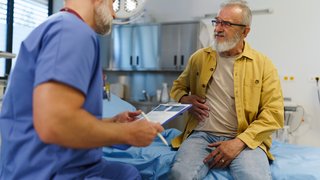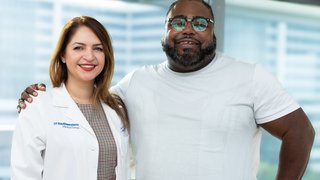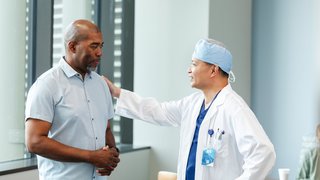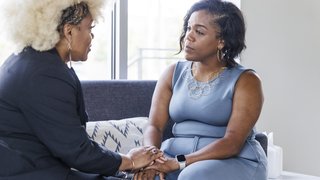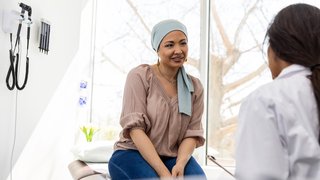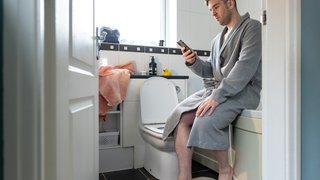
You’ve probably heard those old views over the years regarding clinical trials – that they’re only for very sick people with no other options, or that researchers treat clinical trial patients like guinea pigs and monitor their every move.
Those statements couldn’t be more wrong.
Patients who participate in cancer clinical trials receive the highest standard of care – regardless of their type or stage of cancer – and certain patients also receive additional medication that can result in a more positive outcome.
In this past year, approximately 600 patients participated in nearly 200 different clinical trials at UT Southwestern. The trials took place at Parkland Memorial Hospital and Harold C. Simmons Comprehensive Cancer Center – the only comprehensive cancer center in the region designated by the National Cancer Institute.
Many of our clinical trials are done in cooperation with other institutions nationwide, offering us a clear picture of which drugs are the most effective and which are ineffective.
One patient’s story
To illustrate how a clinical trial works, let me tell you about a patient with metastatic lung cancer who joined one of our clinical trials a decade ago. She received a drug that, at the time, had been approved for a different disease but was still in the testing phase for lung cancer.
The patient had an amazing response. Her cancer disappeared. I was just blown away! I thought, “Wow, this is really impressive. We never see this with standard chemotherapy.”
Several years went by, and the trial closed. I thought the trial’s co-sponsors would certainly market the drug for lung cancer – look what it did for our patient! Well, it turns out that of all the people in that trial, she was the only one who responded like that. No one else showed anywhere close to that kind of improvement, so the drug was never pursued as a lung cancer treatment.
Though clinical trials are experimental, all participants receive, at the least, the level of treatment they’d get if they weren’t in the clinical trial. But, as was the case with this patient, they also have the potential benefit of receiving an additional drug that may improve their outcome.
Who’s a good candidate for a clinical trial?
Any cancer patient who is still mobile and active should think about joining a cancer clinical trial. Almost all of our trials require patients to be at performance status zero, one, or two on the ECOG performance status evaluation:
- Zero means you’re fully functional, you aren’t bedridden, and you can manage your own personal care needs.
- One means you’re not bedridden and you take care of the majority of your own personal care needs.
- Two means you’re bedridden less than 50 percent of the time and you can still manage most of your own personal care needs.
Patients who don’t meet these guidelines are not ideal candidates for clinical trials because they likely will not benefit from additional medication. Also, we don’t want to interrupt their current treatment with the additional testing a trial requires.
Why do people participate in clinical trials?
In general, I see people join cancer clinical trials for three main reasons:
- No further standard treatment is available. This is the most common reason people seek clinical trials. They aren’t ready to give up hope, and neither are we.
- There’s the potential for a better outcome. Clinical trials offer the chance to try medications that are potentially effective but not yet available to the public.
- Participants have a desire to help future cancer patients. Many participants have an altruistic nature – they really want to help future cancer patients, even if the experimental drug does not work for their own cancer. It’s a way of leaving a legacy – they help contribute to our knowledge.
We can never guarantee that an experimental drug will be effective for every cancer patient. That’s why clinical trials are so important – we can discover which drugs work for the largest number of participants and potentially offer them to more people once the trial is over.
I-SPY trial for breast cancer
At Simmons Cancer Center and Parkland, we’re involved in a fascinating breast cancer trial called I-SPY. The study is exactly what it sounds like – we’re looking for biological markers that can predict responses throughout treatment.
The study incorporates experimental drugs based on the molecular characteristics of patients’ tumors. Participants undergo a few additional biopsies and other medical tests before starting the trial, which may slightly delay the start of treatment. Most patients want to start treatment right away, which is completely understandable. However, the additional tests give us insight into their specific cancer and help us determine the most appropriate treatment.
We’re rapidly learning that certain drugs may result in significant benefits – with potentially fewer negative side effects. Recently, I’ve had two patients who received chemotherapy along with two different experimental drugs, and the results were very interesting.
One patient had virtually no negative side effects. She got what we call a complete pathologic response – in other words, when she went to surgery, her tumor was completely gone. That’s the very best situation that you can have in breast cancer.
The other patient is now responding very well to chemotherapy, but the experimental drug she received caused too many negative side effects. We discontinued the experimental drug because it was not beneficial to her treatment.
That type of comparison contributes to our knowledge base – if one drug improves patient outcomes with no negative side effects and a second drug causes side effects, the second drug has to show dramatic improvements in patient outcomes or it will not be considered for use outside the trial.
How clinical trials help
There’s no single cancer treatment we can use that has a 100-percent response rate.
One of the goals of trying new treatments is to learn how to help patients feel better. Not all patients will have improved outcomes. But when they do, researchers get one step closer to opening the door for improving cancer treatment nationwide.


